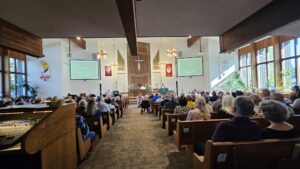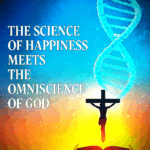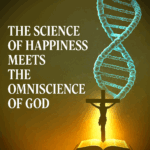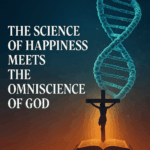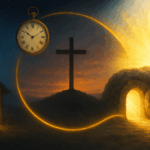“Music for the Dance” – John 15/16
1. Literary comparisons to Jesus
Various authors have described the life, death and resurrection of Jesus using unique comparisons. For instance, in his Chronicles of Narnia, C. S. Lewis used the killing of the lion, Aslan, on the Stone Table at the hands of the White Witch, and Aslan’s return to life the next morning to parallel the story of Jesus.
For those of you who are fans of J. R. R. Tolkien’s Lord of the Rings, Jesus is there, too, in that story of the ultimate battle between good and evil in Middle Earth. While there may be no one complete, concrete, visible Christ-figure in that trilogy, some have identified reflections of Jesus, facets of His personality, in three of the heroes: Gandalf, Frodo and Aragorn. They exemplify that three-fold Old Testament Messianic symbolism of prophet (Gandalf), priest (Frodo), and king (Aragorn).
It was just over 45 years ago that Baptist author Calvin Miller first published his book, The Singer. It is a classic and powerful retelling of the life of Jesus Christ. In the somewhat poetically-styled story, Jesus is cast as a singer, and the Gospel is his song. He begins as a Tradesman, but his true nature is as the Troubadour or Singer who created the universe with the words of His Star-Song. The Singer encounters His enemy, the World-Hater many times during His travels, but He knows that His purpose is to captivate people with His Star-Song, and to heal the minds and the bodies of those He meets along the way.
In a journey similar to Jesus’ Palm Sunday entrance into Jerusalem, the Singer goes to the Great Walled City of the Ancient King. That city’s people practice the old, traditional religion. The Singer frees the Madman with His Song, but that serves to stir up a crowd, and to anger the Musicians of the old religion. Together they kill the Singer on the Great Machine of Death – a torture rack. The Singer’s mother and one person He had healed go to comfort the Madman, while the Singer comes back alive, rising from the crumpled ruins of the Machine of Death.
Miller’s sequel is called the Song, and it parallels the Book of Acts. The Song is about the battle between the World Hater and those who hear, embrace, and try to pass on the Singer’s Star-Song. As the former Madman is changed into Anthem via a Holy Spirit entity called the Invader, the World Hater renames himself Sarkon and reinvents a religion to compete for people’s hearts.
After Anthem speaks to a crowd in the marketplace, the Invader enters hundreds of people in a way similar to Pentecost in the Bible. In retaliation, Sarkon uses knowledge and science to distract Everyman from the Star-Song of the Singer and those who follow His way of life. Anthem uses the Singer’s name to reveal the lies of Sarkon, and Everyman embraces the Song. Sarkon uses more trickery to arouse the city crowds to attack the followers of the Singer. Given a vision, Anthem and Everyman leave the Great Walled City and head to Urbis, the capital of the world. This reminds us of Paul’s missionary journeys, and specifically Paul’s going to Rome to preach the Good News of Jesus.
A third volume of Calvin Miller’s three-fold story is called “The Finale” and it is an allegory of the Book of Revelation in the Bible.
So, why all these story comparisons to the life and ministry, the death and resurrection of Jesus? Because today I want to use another comparison to illustrate how the Holy Spirit – given on that first Pentecost Day – leads and guides and shapes our lives to present Jesus to our world. The comparison is to that of “Music for the Dance” – the sermon title – and it relates most closely to Miller’s Singer and Song stories and images.
2. Dancing
In the olden days – and you can imagine for yourself when those olden days were – some Christians did not dance. They considered dancing to be immoral, especially if you were dancing with someone that you weren’t married to. It could lead to lust, and lust could lead to adultery, so better not to dance at all – not even at a family wedding. [Oh, and some Christians still today consider dancing to be wrong. Maybe it’s still the olden days.] For some reason, my dad never learned to dance. So, when he and my mom got married, even though she was open to dancing, she decided NOT to dance – so that my dad wouldn’t get jealous of her dancing with someone else, watching to see how close they got, or to see how much fun my mom was having with another man, and not knowing what they were talking about. Somehow, though, I learned to dance some polkas and waltzes at those family weddings, and you could always tell who really felt the music. They didn’t have to think about it, they just did it, they moved to the music, and you could tell they were having fun. I went to some of those high school dances where all you did was move your feet and your arms rather arbitrarily. In fact, I remember going to a dance in Grade 8. Linda was there, the girl with straight blonde hair, the girl I had a crush on. Alas, I was too shy to even ask her to dance, and then she went to a different high school, so I never did get to dance with her. In university, I took a Phys. Ed. department dance class, to improve my skills… and to get an easy credit!! Before Deanna and I got married, we took a ballroom dance class together, so we learned a few more dance steps – like the fox-trot, and the rumba, and the romantic tango. In my first parish, we joined a dance club in our little town, but most of the participants were old enough to be our grandparents. I still enjoy dancing.
3. Dancing by the book
But imagine this… imagine that you didn’t have any dancing experience while you were growing up, and now you want to learn to dance. So, you go to a bookstore, or to the library and you get a book on dancing. Oh… no… that’s the olden days way. These days, you google it, and find an online resource to teach you how to dance… because google can teach you how to install a new toilet, or how to make a delicious beef dip, or how to prune your blueberry plants. So, google can surely teach you how to dance.
You call up the site, and get to work. It says sway, and you sway. It says shuffle, and you shuffle. It says spin, and you spin. If it tells you to count to three for that waltz, you obediently count to three. If it tells you to do a box-step for that fox-trot, you cut out paper shoe patterns and place them around the floor so you’ll know exactly where to step.
Finally, when you think you’ve got it, you invite your wife or husband to come in and watch. You look at the computer screen, and follow the instructions. Sway, lean, step, turn. You watch, dance, read, dance and then you’re done, and you say to your wife, “I executed it perfectly.”
She replies, “You executed it all right… you basically killed that dance!!”
You see, the trouble was – you forgot the most important part… the music!! You remembered the lesson. You learned the rules. You laid out the pattern. You executed the steps. But you forgot the music.
4. Pentecost – the Holy Spirit as our music
Sometimes, as Christians, we are so concerned about the dance steps of our life of following Jesus that we completely ignore the music. We understand the chapters. We memorize the verses. We discuss the rules, and maybe even master the doctrines. We stiffly step down the dance floor of our Christian life, but we have no music in our hearts. We may do it right, but we don’t feel the music inside. Using Calvin Miller’s analogy, we have been distracted from the captivating Star-Song of the Singer. Pentecost is about the Invader, the Holy Spirit, the music-maker for the song of Jesus in our lives, the one who enables us to dance.
We heard that account today from Acts chapter 2 – but not with music imagery. The Invader, the Spirit, was sent – accompanied by three supernatural signs – a sound, a sight, and strange speech. The sound was not the sound of music, but a mighty rushing wind. The sight was neither a band nor step patterns on the floor, but tongues of fire on the followers of Jesus. The strange speech was not the lyrics of the hottest new song, but the many languages which were spoken – all proclaiming the mighty works of God, the fulfilled sending of the promised Holy Spirit, and the precious message that everyone who calls on the name of the Lord Jesus will be saved.
In the John 15 and 16 Gospel reading, we heard Jesus say that He would send the Helper, the Spirit of Truth, who proceeds from the Father. Now, if I asked you to describe the Heavenly Father, you would probably respond identifying God as the creator, maybe even YOUR creator, and the one who provides and protects and sustains you. If I asked you to tell me what Jesus did for you, you wouldn’t hesitate to point to His suffering and death on the cross, and His resurrection from the tomb – all for your forgiveness and your redemption and your salvation. But if I were to ask you about the role of the Holy Spirit in your life… you might get a blank look on your face, your eyes would glaze over or maybe duck to the side, you might clear your throat, until you finally say, “Ask Sam, or Sally… they know.”
Of the three persons of the Godhead – oh, and that’s next Sunday, Trinity Sunday – of the three persons of the Godhead, the Holy Spirit is the one we seem to understand the least. And the most common mistake is regarding the Spirit as a power, but not a person, as a mighty rushing wind or a tongue of fire, but with no identity. The Holy Spirit is not an “it.” The Holy Spirit is not an impersonal force – not Popeye’s spinach, nor the surfer’s wave, nor a KiloWatt of electrical power. The Holy Spirit is a person of the Godhead, just like the Father, just like the Son. That’s why Jesus said, “When the Helper comes… HE will bear witness about me,” and “I will send HIM to you.” Maybe you’ve seen this “Intel Inside” logo on a computer. Two thousand years ago, St. Paul’s slogan was “Holy Spirit Inside.” That’s what he wrote to the Corinthians – “your body is a temple of the Holy Spirit.” The Holy Spirit is God inside you, within you to help you.
5. What does the Holy Spirit do?
It’s kind of like 30 years ago when I was helping my youngest daughter learn to ride a bicycle. She had already mastered pedaling and balancing with the training wheels on. Now it was time to set her free. She got on the bike on our little-traveled street. I was behind her, at the side, holding the seat of her bike. It was time to go. I pushed a little, and she started pedaling. It was wobbly at first, but I ran alongside and steadied her balance with my hand on the seat. As she got going a bit faster, she was able to go straight and I gently let go of the seat, but I still ran alongside to give her confidence, and to steady the bike if she got a bit wobbly again. After a while, I just got her going, and off she went by herself.
The Holy Spirit does that for us. The Holy Spirit is our bike-riding teacher, or using today’s analogy… our dance coach, AND the one who leads. But while I eventually let my daughter’s bike go, the Holy Spirit never leaves us. What does Jesus say the Holy Spirit does?
He points to Jesus. Jesus said, “When the Helper comes, whom I will send… He will bear witness about me.” That’s what the Holy Spirit did, especially on that first Pentecost Day. The people gathered in Jerusalem heard the “mighty works of God.” St. Peter clarified: “Jesus of Nazareth was the one who did the mighty works of God. He was crucified and killed, but God raised Him up, and we are witnesses of that. You are witnesses that God’s promised Holy Spirit has been poured out today. God has made this Jesus both Lord and Christ, the one who was crucified for the forgiveness of your sins. Everyone who calls upon Him will be saved.” That’s pointing to Jesus if you ask me. It’s pointing YOU to Jesus. It’s pointing you to His forgiveness for those times that you awkwardly and robotically and stiffly and maybe even half-heartedly dance your Christian life. For Jesus is also YOUR Lord and Christ, YOUR forgiver, YOUR Saviour. That’s the primary work of the Holy Spirit – pointing people to Jesus, calling people to faith in Jesus. But there is more…
He comforts the saved. Jesus said, “When I go away, I will send the Helper to you.”
He convicts the lost. Jesus said, “When the Helper comes, He will show the people of the world the truth about sin, about being right with God, and about judgment.”
He conveys the truth. Jesus said, “When the Spirit of truth comes, He will guide you into all the truth.” I found an inspirational little poem on this subject by the famous author… Author Unknown. It’s called “Dancing with God” and it goes like this:
Dancing With God
When I meditated on the word Guidance, I kept seeing ‘dance’ at the end of the word.
I remember reading that doing God’s will is a lot like dancing.
When two people try to lead, nothing feels right.
The movement doesn’t flow with the music, and everything is quite uncomfortable and jerky.
When one person realizes that, and lets the other lead, both bodies begin to flow with the music.
One gives gentle cues, perhaps with a nudge to the back or by pressing lightly in one direction or another.
It’s as if two become one body, moving beautifully.
The dance takes surrender, willingness, and attentiveness from one person and gentle guidance and skill from the other.
My eyes drew back to the word Guidance.
When I saw ‘G,’ I thought of God, followed by ‘u’ and ‘I.’
“God, ‘u’ and ‘I’ dance.” God… you, and I dance.
As I lowered my head, I became willing to trust that I would get guidance about my life.
Once again I became willing to let God lead.
Going back to our analogy… St. Paul wrote to the Romans that “If Christ is in you, then the Spirit gives you life.” That is to say that the Holy Spirit provides the music for the dance of our lives of following Jesus. Is Paul saying that we don’t need the book in order to dance? No… Paul helped write the book including those words about the Spirit, and disciple John recorded Jesus’ words promising the Helper, and Luke, who wrote the book of Acts, described the sending of the Invader, complete with a sound, and a sight, and a speech that set the disciples to dancing, and singing the ancient Star-Song that the Singer first sang and taught.
We need the book. We need to know the dance steps – the chapters, the verses, the doctrines. But we also need to hear the music that the Holy Spirit plays for us – the joy of believing, truly believing, that Jesus is Lord and Christ, that He died to forgive our sin, that He rose again to secure our salvation, that He’s coming back one day to take us to His eternal home, OUR eternal home. All of that sets our hearts to dancing.
6. Dancing in the Bible
Let me tell you about three occasions for dancing in the Bible. When the Israelites had crossed the Red Sea, escaping slavery in Egypt, and when the horses and chariots and horsemen of the Pharaoh all drowned in the sea, then Miriam and all the women danced – with music and tambourines.
When the holy ark of God’s covenant with the people of Israel was finally being brought into Jerusalem, King David danced before the Lord with unrestrained joy.
When the run-away son in Jesus’ parable returned home, his father called for a celebration – complete with the best robe for his lost son, and a ring, and sandals, and a fattened calf, with music and dancing.
In each case, there was ample reason for that dancing. In each case, the people had the music of the Holy Spirit filling them with inexpressible joy. That’s what this day is about – the joy of our salvation assured by Jesus’ death and resurrection, and the music of the Holy Spirit setting our feet and our hearts and our lives a-dancing. Amen.

